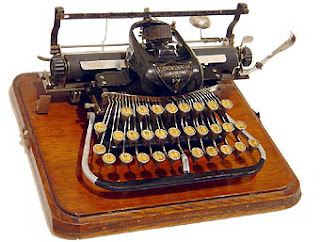Typewriter talk taking over a British motoring magazine? The passing mention of a 1892 typewriter still in good working order in 1961 sparked a flurry of correspondence to Motor Sport. In the issues for August and September of that year, subscribers seemed determined to outdo one another with claims about their old, still-in-use writing machines, rather than their vintage racing cars.
The first came from a reader who “regularly uses an 1896 Remington Standard No 7 (Alan Seaver's seen above), which has cost only 9 shillings for replacements in 13 months, these being a new ribbon and a new fabric band connecting the spring to the carriage”. The correspondent went on, “All the keys produce letters and all the mechanics work as they are meant to … I certainly would not part with it for any modern machine; I consider the £5 it cost well spent.”
“Any others?” editor William Boddy invited. He might have regretted doing so. In the following month’s edition, five typewriter-related letters dominated his magazine’s “Vintage Postbag”. F. B. Humphrey of Ipswich wrote in praise of his Oliver No 9 (another photo from Alan Seaver's wonderful collection, below) “bought for £1 twelve years ago. It was made in 1913 …” “The conclusion is that vintage machinery is completely practical and reliable and far more economical to ‘run’ than present-day tinware.”
James B. Nadwell of Dumfries in Scotland China
R. Michael Dawe of Highgate was using a Blickensderfer No 7 (below, from Richard Polt's great collection) - though, like many present-day eBay sellers, he believed it had been manufactured as early as 1892. “The mechanics of this machine are a joy to behold – and all for 2 shillings and 6 pence at a jumble sale. It has not been used much so would you advise raising the compression-ratio and fitting Webers; this should improve performance, because having a repertoire of 84 symbols it takes rather a time to isolate the one desired!”
Thirteen-year-old Peter Marx of Ferndown was writing on an Empire “portable” (below, from the Martin Howard collection) with a patent date of March 29, 1892. “It has given me reliable service for a year, since purchased at an auction, together with a carpet sweeper, for the princely sum of 10 shillings.” Assuming this Peter Marx was now 63 or thereabouts, and had turned out to be an astute entrepreneur, I Googled the name – there are 25 Peter Marxes who are professionals listed by LinkedIn.
Finally, H.N.Holden of Bath wrote about a Remington Standard No 2 bought at auction by his father for 10 shillings. “The key-bed is in the form of a well and the rods connecting the keys to the letters are made of wood for part of the way, followed by metal wires about as thick as bicycle-wheel spokes …”.
There was some mention of cars in amongst all this. Lincoln MP Geoffrey de Freitas had found a long-cherished Ruston-Hornsby 1922 tourer (the 1920 model pictured below) “spotted in poor condition in Sydney, NSW ... It is believed that one other Ruston-Hornsby is in existence”. De Frietas was preparing to have the car shipped back to England
I am indebted to Peter Gentry of Queanbeyan, outside Canberra






No comments:
Post a Comment